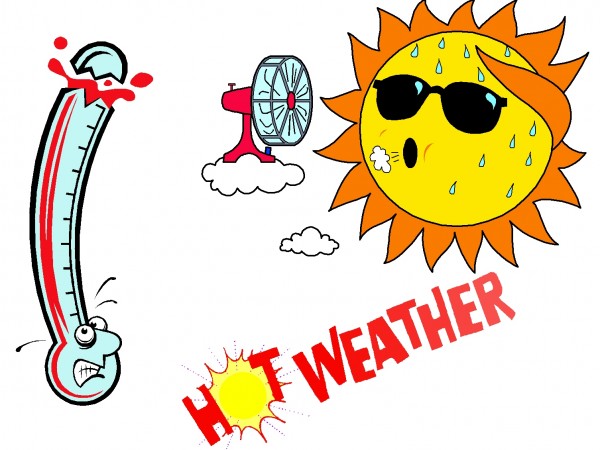When the weather gets hot, there are some basic hydration guidelines you should follow before, during and after your training sessions. However, when the summer months kick into high gear and the rise in temperature and humidity cause you to break out in a sweat the moment you walk out the door, it’s time to step up your hydration plan. Read on for some key points to consider during these summer scorchers:
Your Heart Rate Will Be Impacted
During the months when temperatures and humidity are higher than your body is accustomed to, realize that your heart rate will disconnect from pace due to heart beats associated with cooling the body. As your body cools itself, it pushes blood volume to the surface. This blood volume is then not available for oxygen delivery to your muscle cells. As your body tries to meet the oxygen demand asked by your muscles, it has no choice but to beat more often with the lower blood volume it has available for oxygen delivery. Because of this, expect to see heart rates 8-10 beats above normal in the warmest conditions.
Measure Your Sweat
Each runner needs to be treated as an individual, but there are some averages, such as sodium loss per liter, that will be useful in putting a hydration plan together. Check out this simple test which can help you better understand your sweat rates and sodium losses:
1.Weigh yourself before and after a run without clothes on. For most people, losing two or more pounds is too much. Keep in mind that a 2% dehydration or more impacts performance. A loss of 5% and greater can become very dangerous. For a 150-pound runner, this is a 3 pound loss for 2% dehydration and a 7.5 pound loss for 5%. To determine your sweat rate, perform asweat test:
- Take your “no clothing” body weight before a one-hour moderate intensity bike or run.
- Record the amount of liquid consumed during workout, and weigh yourself again after the workout.
- Calculate the weight change and remember to add in the amount of liquid consumed during the workout.
- Every pound is equal to 16 oz of fluid.
2.Are your training clothes suddenly white after a workout? Does your face and body feel “crusty?” Have you had muscle cramping in hot weather? If so, then you probably have a higher concentration of sodium in your sweat relative to the “average” person.
- Average sweat rate is typically 1 – 1.5L of fluid per hour (32 – 48oz), and 1,000 – 1,500mg of sodium per hour while running (a bit less when cycling).
- Sweat rate will depend on several factors including environmental conditions (temperature, humidity), genetics, and the athletic conditioning of the athlete (use the sweat test above to help you cue in to your specifics).
- Most people’s sweat contains about 500mg of sodium per 16oz. Very salty sweaters can have up to 1,200mg per 16oz of sweat.
Understanding where you may fall on the sodium concentration scale, combined with understanding your fluid losses can help better estimate your sodium needs during training and racing. For example, if your sweat rate was determined to be 32oz/hour, and you estimate your sodium loss to be 500mg/16oz, your sodium need is 1,000mg/hour.
Most athletes vastly underestimate their sodium needs. Those who have experienced the sloshy gut or muscle cramping likely fall into this category! Consider sodium supplements and fueling products that contain more sodium than most products in addition to electrolyte replacement beverages.
Use a Fuel Belt or Bottle
A fuel belt or bottle is used for the same reason you wear light weight “race flats” in short distance races – to run faster!
How?In cooler weather temperatures, you can get away with not carrying hydration with you on runs shorter than 1 hour, but only if you are properly hydrated on a daily basis. However, during hot and humid months, wearing a fuel belt or bottle for all runs will only be a benefit to you, especially if you do not have access to fluids every 15 minutes.
Why?The goal is to not only stay hydrated and fueled for the workout you are currently performing, but also to prepare the body for the future workouts in days to come.
The goal is to drink 6-10 ounces of a sodium and electrolyte containing drink, such asNuun Active Hydration, every 15 minutes to avoid dehydration and provide the fuel needed. Fuel belts and bottles are the perfect solution for any run during the summer months, and are a necessity for those training for long distance events.
Rehydrate, Rehydrate, Rehydrate
You cannot replace all of the fluids lost through sweating when training, but you need to replace those fluids after. Your fluid rehydration plan does not need to include carbohydrates (you’ll get that from your recovery drink and post-workout meal), but it should contain some electrolytes. We always get asked when the best time to use an electrolyte tablet. When you jump on the scale and realize you’ve lost 3 pounds (48 ounces) through sweat, add aNuuntablet to your water bottle and you are setting yourself up for a cramp-free, better quality workout session the next day.
If you are left feeling confused with you personal fluid needs, check out ourrace fueling plansand take the guess out of it!
Enjoy your summer running!















Comments